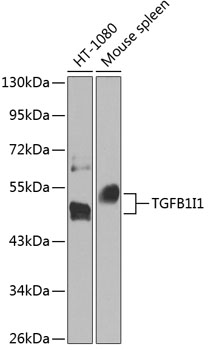Developmental Biology
Anti-TGFB1I1 Antibody (CAB8459)
- SKU:
- CAB8459
- Product Type:
- Antibody
- Applications:
- WB
- Reactivity:
- Human
- Reactivity:
- Mouse
- Host Species:
- Rabbit
- Isotype:
- IgG
- Research Area:
- Developmental Biology
Description
| Antibody Name: | Anti-TGFB1I1 Antibody |
| Antibody SKU: | CAB8459 |
| Antibody Size: | 20uL, 50uL, 100uL |
| Application: | WB |
| Reactivity: | Human, Mouse |
| Host Species: | Rabbit |
| Immunogen: | Recombinant fusion protein containing a sequence corresponding to amino acids 1-150 of human TGFB1I1 (NP_001035919.1). |
| Application: | WB |
| Recommended Dilution: | WB 1:500 - 1:2000 |
| Reactivity: | Human, Mouse |
| Positive Samples: | HT-1080, Mouse spleen |
| Immunogen: | Recombinant fusion protein containing a sequence corresponding to amino acids 1-150 of human TGFB1I1 (NP_001035919.1). |
| Purification Method: | Affinity purification |
| Storage Buffer: | Store at -20'C. Avoid freeze / thaw cycles. Buffer: PBS with 0.02% sodium azide, 50% glycerol, pH7.3. |
| Isotype: | IgG |
| Sequence: | MEDL DALL SDLE TTTS HMPR SGAP KERP AEPL TPPP SYGH QPQT GSGE SSGA SGDK DHLY STVC KPRS PKPA APAA PPFS SSSG VLGT GLCE LDRL LQEL NATQ FNIT DEIM SQFP SSKV ASGE QKED QSED KKRP SLPS SPSP GLPK AS |
| Gene ID: | 7041 |
| Uniprot: | O43294 |
| Cellular Location: | Cell junction, Cytoplasm, Nucleus matrix, cytoskeleton, focal adhesion |
| Calculated MW: | 47kDa/49kDa |
| Observed MW: | 50kDa |
| Synonyms: | TGFB1I1, ARA55, HIC-5, HIC5, TSC-5 |
| Background: | This gene encodes a coactivator of the androgen receptor, a transcription factor which is activated by androgen and has a key role in male sexual differentiation. The encoded protein is thought to regulate androgen receptor activity and may have a role to play in the treatment of prostate cancer. Multiple transcript variants encoding different isoforms have been found for this gene. |
| UniProt Protein Function: | Hic-5: Functions as a molecular adapter coordinating multiple protein-protein interactions at the focal adhesion complex and in the nucleus. Links various intracellular signaling modules to plasma membrane receptors and regulates the Wnt and TGFB signaling pathways. May also regulate SLC6A3 and SLC6A4 targeting to the plasma membrane hence regulating their activity. In the nucleus, functions as a nuclear receptor coactivator regulating glucocorticoid, androgen, mineralocorticoid and progesterone receptor transcriptional activity. May play a role in the processes of cell growth, proliferation, migration, differentiation and senescence. May have a zinc-dependent DNA- binding activity. Homooligomer. Interacts with CRIP2, HSPB1, ILK, LIMS1, LIMS2, NCK2, NUDT16L1, PAK, PPARG, PTPN12, TCF3, TCF7L2 and VCL. Forms a complex with GIT1 and ARHGEF7. Interacts with AR/androgen receptor in a ligand-dependent manner. Interacts with CSK, LYN, MAPK15, NR3C1, PPARG, PTK2/FAK1, PTK2B/PYK2, SLC6A3, SLC6A4, SMAD3, SRC and talin. Up-regulated by TNF and hydrogen peroxide. Expressed in platelets, smooth muscle and prostate stromal cells. Belongs to the paxillin family. 2 isoforms of the human protein are produced by alternative splicing. |
| UniProt Protein Details: | Protein type:Transcription, coactivator/corepressor; Nuclear receptor co-regulator; Motility/polarity/chemotaxis Chromosomal Location of Human Ortholog: 16p11.2 Cellular Component: extracellular matrix; focal adhesion; cytoskeleton; nuclear matrix; cytoplasm; intracellular Molecular Function:protein binding; Roundabout binding; androgen receptor binding; zinc ion binding; transcription coactivator activity Biological Process: transcription from RNA polymerase II promoter; cell fate commitment; Wnt receptor signaling pathway; positive regulation of transcription, DNA-dependent; positive regulation of transforming growth factor beta receptor signaling pathway; negative regulation of fat cell differentiation; ubiquitin-dependent SMAD protein catabolic process; negative regulation of cell proliferation; morphogenesis of embryonic epithelium; epithelial cell differentiation; response to heat; androgen receptor signaling pathway; cell adhesion; negative regulation of transforming growth factor beta receptor signaling pathway |
| NCBI Summary: | This gene encodes a coactivator of the androgen receptor, a transcription factor which is activated by androgen and has a key role in male sexual differentiation. The encoded protein is thought to regulate androgen receptor activity and may have a role to play in the treatment of prostate cancer. Multiple transcript variants encoding different isoforms have been found for this gene. [provided by RefSeq, Sep 2009] |
| UniProt Code: | O43294 |
| NCBI GenInfo Identifier: | 119572515 |
| NCBI Gene ID: | 7041 |
| NCBI Accession: | EAW52130.1 |
| UniProt Secondary Accession: | O43294,Q9BPW3, Q9Y2V5, B2R8D5, |
| UniProt Related Accession: | O43294 |
| Molecular Weight: | 49,814 Da |
| NCBI Full Name: | transforming growth factor beta 1 induced transcript 1, isoform CRA_a |
| NCBI Synonym Full Names: | transforming growth factor beta 1 induced transcript 1 |
| NCBI Official Symbol: | TGFB1I1 |
| NCBI Official Synonym Symbols: | HIC5; ARA55; HIC-5; TSC-5 |
| NCBI Protein Information: | transforming growth factor beta-1-induced transcript 1 protein; androgen receptor coactivator ARA55; hydrogen peroxide-inducible clone 5 protein; androgen receptor coactivator 55 kDa protein; androgen receptor-associated protein of 55 kDa |
| UniProt Protein Name: | Transforming growth factor beta-1-induced transcript 1 protein |
| UniProt Synonym Protein Names: | Androgen receptor coactivator 55 kDa protein; Androgen receptor-associated protein of 55 kDa; Hydrogen peroxide-inducible clone 5 protein |
| Protein Family: | Transforming growth factor-beta-induced protein |
| UniProt Gene Name: | TGFB1I1 |
| UniProt Entry Name: | TGFI1_HUMAN |







